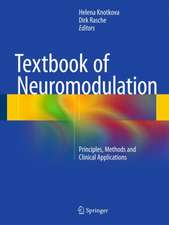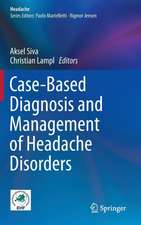Clinical Systems Neuroscience
Editat de Kenji Kansaku, Leonardo G. Cohen, Niels Birbaumeren Limba Engleză Hardback – 2 mar 2015
| Toate formatele și edițiile | Preț | Express |
|---|---|---|
| Paperback (1) | 782.72 lei 39-44 zile | |
| Springer – 6 oct 2016 | 782.72 lei 39-44 zile | |
| Hardback (1) | 728.52 lei 6-8 săpt. | |
| Springer – 2 mar 2015 | 728.52 lei 6-8 săpt. |
Preț: 728.52 lei
Preț vechi: 766.87 lei
-5% Nou
Puncte Express: 1093
Preț estimativ în valută:
139.41€ • 149.07$ • 116.23£
139.41€ • 149.07$ • 116.23£
Carte tipărită la comandă
Livrare economică 17 aprilie-01 mai
Preluare comenzi: 021 569.72.76
Specificații
ISBN-13: 9784431550365
ISBN-10: 4431550364
Pagini: 180
Ilustrații: XI, 387 p. 137 illus., 104 illus. in color.
Dimensiuni: 155 x 235 x 22 mm
Greutate: 0.74 kg
Ediția:2015
Editura: Springer
Colecția Springer
Locul publicării:Tokyo, Japan
ISBN-10: 4431550364
Pagini: 180
Ilustrații: XI, 387 p. 137 illus., 104 illus. in color.
Dimensiuni: 155 x 235 x 22 mm
Greutate: 0.74 kg
Ediția:2015
Editura: Springer
Colecția Springer
Locul publicării:Tokyo, Japan
Public țintă
Professional/practitionerCuprins
Brain-Machine Interfaces in Stroke Neurorehabilitation.- Practical Noninvasive Brain–Machine Interface System for Communication and Control.- How Many People Can Use a BCI System?.- Motor Control Theory and Brain Machine Interfaces.- Electrocorticographic Brain Machine-Interfaces for Motor and Communication Control.- Theoretical Basis for Closed-Loop Stimulation as a Therapeutic Approach to Brain Injury.- Large-Scaled Network Reorganization During Recovery from Partial Spinal Cord Injury.- Reconstruction and Tuning of Neural Circuits for Locomotion after Spinal Cord Injury.- The Cognitive Neuroscience of Incorporation: Body Image Adjustment and Neuroprosthetics.- Body Representation and Neuroprosthetics.- Using Image Adjustments for Producing Human Motor Plasticity.- Engineering Approach for Functional Recovery based on Body Image Adjustment by using Biofeedback of Electrical Stimulation.- Chronic Pain and Body Experience – Neuroscientific Basis and Implications for Freatment.- Motor Control of the Hand Before and After Stroke.- Effects of Successful Experience and Positive Feedback on Learning and Rehabilitation.- Context-Dependent Formation and Retrieval of Human Motor Memories.- Real-Time Magnetoencephalography for Neurofeedback and Closed-Loop Experiments.- Changes in Human Brain Networks and Spontaneous Activity Caused by Motor and Cognitive Learning.- Visual Perceptual Learning and Sleep.- Testing Cognition and Rehabilitation in Unilateral Neglect with Wedge Prism Adaptation: Multiple Interplays Between Sensorimotor Adaptation and Spatial Cognition.
Recenzii
“The book focuses on systems neuroscience and the latest advances in technology. … The numerous, colorful tables and figures help clarify the text. This book is excellent in discussing new techniques to help individuals with brain impairments. It will be of great benefit to researchers who are interested in brain function disabilities.” (Gary B. Kaniuk, Doody's Book Reviews, May, 2015)
Textul de pe ultima copertă
The impaired brain has often been difficult to rehabilitate owing to limited knowledge of the brain system. Recently, advanced imaging techniques such as fMRI and MEG have allowed researchers to investigate spatiotemporal dynamics in the living human brain. Consequently, knowledge in systems neuroscience is now rapidly growing. Advanced techniques have found practical application by providing new prosthetics, such as brain–machine interfaces, expanding the range of activities of persons with disabilities, or the elderly. The book’s chapters are authored by researchers from various research fields such as systems neuroscience, rehabilitation, neurology, psychology, and engineering. The book explores the latest advancements in neurorehabilitation, plasticity, and brain–machine interfaces among others, and constitutes a solid foundation for researchers who aim to contribute to the science of brain function disabilities and ultimately to the well-being of patients and the elderly worldwide.
Caracteristici
Provides new concepts to apply systems neuroscientific knowledge to practical rehabilitation Covering wide range of patients with motor, sensory and cognitive dysfunctions Covering multiple disciplines such as systems neuroscience, neurology, psychology and engineering












